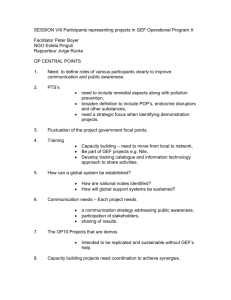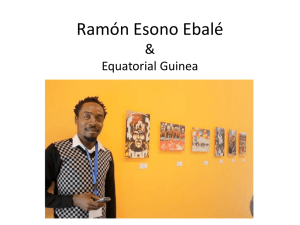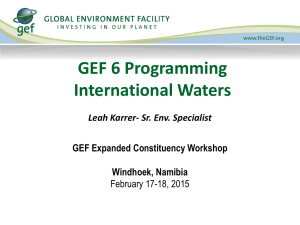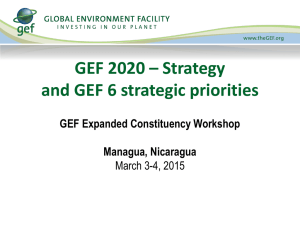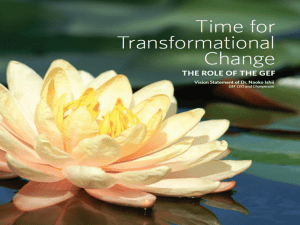FINANCING PLAN (IN US$): - Global Environment Facility
advertisement
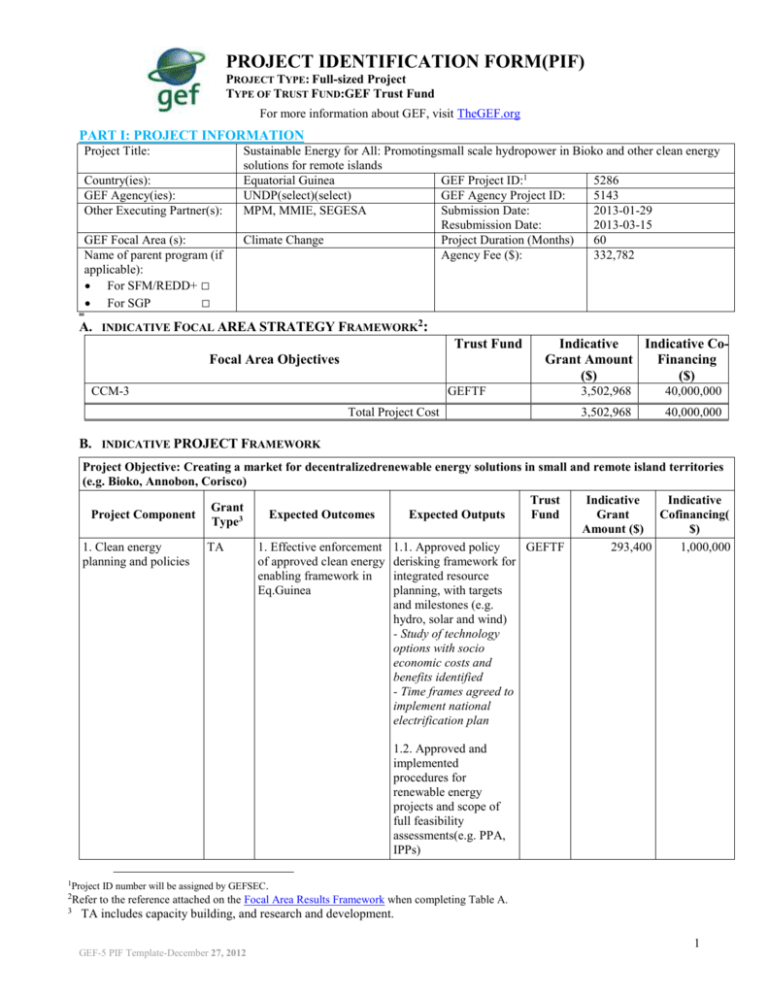
PROJECT IDENTIFICATION FORM(PIF) PROJECT TYPE: Full-sized Project TYPE OF TRUST FUND:GEF Trust Fund For more information about GEF, visit TheGEF.org PART I: PROJECT INFORMATION Project Title: Country(ies): GEF Agency(ies): Other Executing Partner(s): GEF Focal Area (s): Name of parent program (if applicable): For SFM/REDD+ □ For SGP □ Sustainable Energy for All: Promotingsmall scale hydropower in Bioko and other clean energy solutions for remote islands Equatorial Guinea GEF Project ID:1 5286 UNDP(select)(select) GEF Agency Project ID: 5143 MPM, MMIE, SEGESA Submission Date: 2013-01-29 Resubmission Date: 2013-03-15 Climate Change Project Duration (Months) 60 Agency Fee ($): 332,782 00 A. INDICATIVE FOCAL AREA STRATEGY FRAMEWORK2: Trust Fund Focal Area Objectives CCM-3 GEFTF Total Project Cost Indicative Indicative CoGrant Amount Financing ($) ($) 3,502,968 40,000,000 3,502,968 40,000,000 B. INDICATIVE PROJECT FRAMEWORK Project Objective: Creating a market for decentralizedrenewable energy solutions in small and remote island territories (e.g. Bioko, Annobon, Corisco) Trust Indicative Indicative Grant Project Component Expected Outcomes Expected Outputs Fund Grant Cofinancing( 3 Type Amount ($) $) 1. Clean energy TA 1. Effective enforcement 1.1. Approved policy GEFTF 293,400 1,000,000 planning and policies of approved clean energy derisking framework for enabling framework in integrated resource Eq.Guinea planning, with targets and milestones (e.g. hydro, solar and wind) - Study of technology options with socio economic costs and benefits identified - Time frames agreed to implement national electrification plan 1.2. Approved and implemented procedures for renewable energy projects and scope of full feasibility assessments(e.g. PPA, IPPs) 1Project ID number will be assigned by GEFSEC. Refer to the reference attached on the Focal Area Results Framework when completing Table A. 2 3 TA includes capacity building, and research and development. GEF-5 PIF Template-December 27, 2012 1 2. Clean energy technology and business model Inv 2. Transformed on/offgrid renewable energy markets in Bioko island for scale-up/replication in the insular regions - National resource mapping targets - Streamlined RE procurement guidelines 2.1. Completed GEFTF feasibility assessments of technology options for small hydropower, solar and wind in small islands - Definition of technical RET specifications - Review of equipment and long lead items 1,308,730 15,200,000 1,550,730 21,395,238 2.2. Business development plans for selected small hydropower (4.2MW in Bioko island) and alternative renewable energy options for small islands (e.g. wind and solar technologies) - Review and selection of technology options and incentive mechanisms - Reduction of insurer premiums/contingencies 3. Clean energy catalyzed funding Inv 3. Clean energy fundsmobilized for offgriddevelopments in insular regions (e.g. Bioko, Annobon, Corisco) 2.3. Completed pilot project demonstrations of small hydropower plants in Equatorial Guinea’s main insular region - Riaba (3.8MW) - Musola 1 (0.2MW) - Musola 2 (0.2MW) 3.1. Completed and GEFTF documented scaled-up hydropower (i.e. Bioko) and preliminary solar and wind (e.g. Annobon, Corisco) resource assessments - Ilachi (10MW) - Corisco solar (tbc) - Annobon wind (tbc) 3.2. Recommended and endorsed financial derisking measures to implement innovative public and private funding options for GEF-5 PIF Template-December 27, 2012 2 planned renewable energy scale-ups (e.g. CDM, FiTs, equity/debt) - Selection of equity / debt gearing ratios - Feed in tariff / market access mechanisms 4. Clean energy TA knowledge & capacity 3.3. Approved investmentsin additional 10MW hydropower (Ilachi) 4. Clean energy 4.1. Implemented and technical, individual and ongoing technologyinstitutional capacity specific peer-to-peer strengthened learning and mentoring, fostering capacity building on RETs at SEGESA, ITNHGE (MMIE technical institute) and local SMEs - Awareness events led by MPM and MMIE for various stakeholders - Training programme of SEGESA & ITNHGE technicians on RETs GEFTF 183,300 500,000 3,336,160 38,095,238 166,808 1,904,762 3,502,968 40,000,000 4.2. Documented and disseminated best practices/lessons learnedof decentralized electricity solutions nationwide and regionally - Industry conferences and consultations - Project site visits and publications Subtotal Project Management Cost (PMC) 4 Total Project Costs 4 GEFTF To be calculated as a percent of subtotal. GEF-5 PIF Template-December 27, 2012 3 C. INDICATIVE CO-FINANCING FOR THE PROJECT BY SOURCE AND BY NAME IF AVAILABLE, ($) Sources of Cofinancing Name of Cofinancier Private Sector Type of Cofinancing Sociedad Eléctrica de Guinea Ecuatorial S.A. (SEGESA) Ministerio de Minas, Industria y Energía (MMIE) Ministerio de Minas, Industria y Energía (MMIE) National Government National Government GEF Agency Total Cofinancing Amount ($) Grant 39,000,000 Grant 300,000 In-kind 200,000 Cash 500,000 40,000,000 D. INDICATIVE TRUST FUND RESOURCES ($) REQUESTED BY AGENCY, FOCAL AREA AND COUNTRY1 GEF Agency Type of Trust Fund (select) (select) Total Grant Resources Focal Area Grant Amount ($) (a) Country Name/Global Agency Fee ($) (b) Total ($) c=a+b (select) 0 0 0 0 1 In case of a single focal area, single country, single GEF Agency project, and single trust fund project, no need to provide information for this table. PMC amount from Table B should be included proportionately to the focal area amount in this table. 2Indicate fees related to this project. E. PROJECT PREPARATION GRANT (PPG)5 Please check on the appropriate box for PPG as needed for the project according to the GEF Project Grant: Amount Agency Fee Requested ($) for PPG ($)6 No PPG required. (upto) $50k for projects up to & including $1 million (upto) $100k for projects up to & including $3 million (upto) $150k for projects up to & including $6 million (upto) $200k for projects up to & including $10 million (upto) $300k for projects above $10 million --0-……… ……… 150,000 ……… ……… --0-……… ……… 14,250 ……… ……… PPG AMOUNT REQUESTED BY AGENCY(IES), FOCAL AREA (S) AND COUNTRY(IES) FOR MFA AND/OR MTF PROJECT ONLY Trust Fund GEF Agency (select) (select) Total Grant Resources Focal Area (in $) Country Name/ Global PPG (a) Agency Fee (b) Totalc=a+b (select) 0 0 0 0 MFA: Multi-focal area projects; MTF: Multi-Trust Fund projects. 5 6 On an exceptional basis, PPG amount may differ upon detailed discussion and justification with the GEFSEC. PPG fee percentage follows the percentage of the GEF Project Grant amount requested. GEF-5 PIF Template-December27, 2012 4 PART II: PROJECT JUSTIFICATION7 A. PROJECT OVERVIEW A.1. Project Description. Briefly describe the project, including ; 1)the global environmental problems, root causes and barriers that need to be addressed; 2) the baseline scenario and any associated baseline projects; 3) the proposed alternative scenario, with a brief description of expected outcomes and components of the project; 4) incremental cost reasoning and expected contributions from the baseline , the GEFTF, LDCF/SCCF and co-financing; 5) global environmental benefits (GEFTF, NPIF) and adaptation benefits (LDCF/SCCF); 6) innovativeness, sustainability and potential for scaling up i. THE GLOBAL ENVIRONMENTAL PROBLEMS, ROOT CAUSES AND BARRIERS THAT NEED TO BE ADDRESSED 1. Equatorial Guinea is the only Spanish-speaking least developed country (LDC) comprised of island territories (2,050 km 2), where the capital city –Malabo– is based, and a mainland region (26,017 km2), all located in West Central Africa (see maps Annex 1). With a population of 720,000 inhabitants, the country is the third exporter of oil to the US in Sub-Sahara Africa (approx. 320,000 bpd), but imports all its refined oil products significantly for electricity generation. The national utility Sociedad Electrica de Guinea Ecuatorial (SEGESA), has an unreliable power supply with a capacity of 386MW (67% thermal, 33% hydro). Demand is expected to grow at pace with 4-6% GDP growth forecasted for 2012-2016, and population growth of 3% p.a. (EIU, 2012), unlikely to be met with renewables unless investment takes place.Several barriers constrain the required investment drive, as also detailed below. Their comprehensive analysis will be included in the final project document at CEO approval, to confirm their extent, nature, root causes and inter-relationship: Barrier Type Barrier Descriptions Equatorial Guinea's national electrification plan focuses primarily on larger scale, grid extension and transmission Regulatory concerns Policy / Legal: Limited or no legal provisions currently exist for alternative clean energy technologies to hydropower (e.g. solar, Lack of RE wind) strategies and Energy policy decision-making processes (e.g. MMIE and SEGESA) primarily focus on oil and gas developments plans for off Lack of procurement, tendering and licensing processes for electricity generation in Equatorial Guinea grid island and Lack of integration between energy and environmental policies under the environment ministry (MFE) oversight hinterland GHG emission reductions and climate change mitigation are only vaguely present in the current energy agenda remote areas Limited scope for RET entrepreneurship (no market scale) and inexistent technical capacity (suppliers, installers, Institutional / financiers) Technical: Limited hydropower maintenance capabilities, including lack of accountability over asset integrity/efficiency Limited No coverage of climate mitigation concerns within the curriculum of MMIE's technical institute (ITNHGE) institutional capabilities and No knowledge of clean energy (particularly, solar and wind) resource endowments in Equatorial Guinea Lack of awareness and information on the benefits of renewable energy sources in Equatorial Guinea local skills to Limited hydropower, solar or wind energy expertise in Equatorial Guinea's MMIE and MFE embrace RETs Small hydropower capacity is at 2% of the estimated existing capacity (4MW), with newly identified potential Market / (min. 10MW) in Bioko island remains unattractive in terms of scale versus planned large scale (200Mw each) Financial: No developments in the mainland economies of scale and scope High upfront costs (e.g. custom duties) to the introduction of RETs in a small market (eg solar PV up to $15k/Kw) Subsidized petrochemical products do not reflect the actual cost of fuel-generated electricity, deeming RETs identified to expensive leverage RE No consideration of innovative financing mechanisms for RE developments (e.g. feed-in-tariffs, carbon finance) small Market size leads to monopolistic context with no incentive for small scale electricity generation and distribution investments This proposal is designed to address the above constraints to the further diversification of Equatorial Guinea’s energy mix. It is in line with the government’s ambition to ensure the full electrification of the country by 2020. Incremental GEF funding and UNDP support, will enable the baseline projects attain global environmental benefits, by replacing fossil-fuel based electricity usage with the promotion of sustainable energy options. As a result, the country’s energy security will increase in a socially acceptable (e.g. employment potential, local content), economically feasible (e.g. investment scale-up) and environmentally sound manner (e.g. emissions reduced), particularly in Equatorial Guinea’s main islands. ii. THE BASELINE SCENARIO AND ANY ASSOCIATED BASELINE PROJECTS 2. The majority of the installed hydroelectric capacity is located in the mainland (96%), with the recently completed 120MW Djibloho power plant, representing the first of a series of long-term planned large-scale hydropower facilities along the Wele River; however, the insular regions rely almost 100% on fossil-fuel based electricity. Bioko’s gas-fired power plant in Punta Europa (154MW) mainly services Malabo, in the north of the island. In the south, an old 4MW hydro plant in the town of Riaba operates at 2% capacity due to lack of investment, despite increasing economic activity from the nearby 7 Part II should not be longer than 5 pages. GEF-5 PIF Template-December27, 2012 5 freeport in Luba (Bioko’s second biggest town). Small scale hydropower has received little attention, and may only merit it after the planned refurbishment of Riaba and existing micro hydro facilities (e.g. Musola 1 and 2 totaling 0.5MW) actually takes place. These projects and future investments require a number of policy and financial derisking measures (explained in the proposal), in line with country aims to reduce GHG emissions through small scale hydro and, potentially, wind and solar, which will help Equatorial Guinea move away from the business-as-usual scenario tabled below: Component Business-As-Usual / Baseline Scenario 1. Clean energy planning Equatorial Guinea MMIE’s national electrification plan is primarily focusing on grid extension and policies and transmission to upscale electricity generation (particularly, for large hydropower in the mainland), although studies are currently underway for a minimum 10MW hydro plan in Bioko SUBTOTAL Component 1 = $1,000,000 2. Clean energy National utility (SEGESA) has firm installation plans in Riaba and Musola (facilities located in technology and business the south of Bioko island), but it is unclear that considerations of environmental conditions (e.g. model biodiversity, drought, floods) are being fully made. SUBTOTAL Component 2 = $16,000,000 3. Clean energy catalyzed Available public funds from oil and gas revenues bankroll nationwide infrastructure funding developments, including plans for a greenfield (min. 10Mw) hydro plant in Bioko island. UNDP and MMIE interface with oil and gas players on social contributions targeting clean energy (e.g. Noble Energy), may be replicated by other main operators (i.e. ExxonMobil, Marathon Oil, Hess), or for other technologies (e.g. solar, wind) SUBTOTAL Component 3 = $22,500,000 4. Clean energy Ongoing hydro developments, and initial national communication to the UNFCCC (in knowledge and capacity progress), are barely advancing the climate change agenda, with few events (e.g. workshops), none covering climate change mitigation concerns. SUBTOTAL Component 4 = $500,000 TOTAL = $40,000,000 iii. THE PROPOSED ALTERNATIVE SCENARIO, WITH A BRIEF DESCRIPTION OF EXPECTED OUTCOMES AND COMPONENTS OF THE PROJECT 3. The project will promote a reduced dependence of Equatorial Guinea, particularly its island regions, on fossil fuelgenerated electricity, with increased access and consideration of cleaner energy resources (e.g. small scale hydro, solar and wind power). The approach proposed should address the weakness of the country’s policy, market and institutional frameworks, affecting its stretched electricity generation; and tackle the root causes of the associated risks: 4. Component 1: Clean Energy Planning and Policies– promoting the effective enforcement of a clean energy regulatory framework, as the proposed policy de-risking mechanism to increase the probability of planned investments to go ahead: (1.1) Approved policy de-risking framework for integrated resource planning, with targets and milestones – An action plan operationalizes the cleaner energy aspects of Equatorial Guinea’s national electrification plan, including concrete goals, measures and timeframes to increase the country’s electricity generation from hydropower and, potentially, solar and wind; (1.2) Approved and implemented procedures for renewable energy projects and scope of full feasibility assessments – These procedures will streamline any required procurement, licensing and other policy de-risking instruments that would strengthen the enabling environment for clean energy investments (e.g. PPA, IPPs, PPPs, feed-in-tariffs). 5. Component 2: Clean Energy Technology and Business Model– contributing to the transformation of the renewable energy market in Bioko island, which may be scaled-up or replicated in other islands: (2.1) Completed feasibility assessments of technology options for small hydropower in small islands – to provide the necessary technical detail (e.g. minimum river flow, expected rainfall variability, estimated hydropower capacity) to inform the physical specifications of the planned investments (e.g. recommended turbine size and type, adequate rotation speed, grid frequency); (2.2) Business development plans for selected small hydropower and alternative renewable energy options for small islands – these will include the economic/financial features and technical specifications for an estimated 4.2MW –Riaba 3.8MW, Musola1 0.2MW and Musola2 0.2MW– worth of hydropower capacity (e.g. risks, financing, sensitivity analyses); (2.3) Completed pilot project demonstrations of small hydropower plants in Equatorial Guinea ’s main insular region – the investments go ahead following engineering planning and design consistent with the full feasibility studies, climate variability information and other studied socioeconomic/environmental details, and the consequent reduction of risks perceived. 6. Component 3: Clean Energy Catalyzed Funding–mobilizing finance for renewable energy in the insular regions: (3.1) Completed and documented scaled up hydropower in Bioko island, preliminary wind energy in Annobon island, and solar in Corisco islands (with potential replication to mainland coastal locations) – replicated river flow tests and comprehensive wind and solar resource assessments provide detail about additional renewable energy generation potential for investment; (3.2) Recommended and endorsed financial de-risking measures to implement innovative public and private funding options for planned renewable energy scale-ups –different mechanisms to transfer the risks to interested financiers (e.g. treasury, development banks, bilateral donor partners) will be assessed and suggested for implementation (e.g. feed-in-tariffs, carbon finance, other debt/equity instruments, or related price and market-access instruments), which would provide investors with GEF-5 PIF Template-December27, 2012 6 predictable long-term price for renewable energy options, and the consequent revenue, profit and value-added streams; (3.3) Approved investments in additional 10MW hydropower –funding is made available for scaled-up hydroelectric generation along Bioko island’s Ilachi River, following GEF-funded feasibilities, engineering planning and design (e.g. river flow tests, climate V&A assessments), which help reduce associated risks and costs, e.g. sovereign risk, contingencies, etc. 7. Component 4: Clean Energy Knowledge and Capacity– strengthening the technical, individual and institutional capacity to support sustainable energy developments in Equatorial Guinea: (4.1) Implemented and ongoing technology-specific peer-to-peer learning and mentoring, fostering capacity building on RETs at SEGESA, ITNHGE (MMIE technical institute) and local SMEs – national training and development activities with focus on climate change mitigation benefits targeting individuals (e.g. contractors, communities, entrepreneurs) and institutions; (4.2) Documented and disseminated best practices/lessons learned of decentralized electricity solutions nationwide and regionally – Information and knowledge on sustainable energy solutions widely shared nationwide for awareness-raising. iv. INCREMENTAL COST REASONING AND EXPECTED CONTRIBUTIONS FROM THE BASELINE, THE GEFTF, LDCF/SCCF AND CO-FINANCING 8. These activities are expected to result in the following incremental outcomes with GEF-grant support to the baseline: Component 1. Clean energy planning and policies $1,293,400 2. Clean energy technology and business model $17,308,730 3. Clean energy catalyzed funding GEF-supported alternative Fossil-fuel based electricity generation in insular regions will be lessened, legal/policy provisions accommodate for smaller scale, decentralized solutions (e.g. small hydro, solar, wind), appropriate for each location and considering sustainable development concerns (e.g. employment generation, rural women) SUBTOTAL Component 1 = BAU ($1,000,000) + GEF ($293,400) EPC is informed by techno-economic considerations, as appropriate for smaller scale and higher maintenance hydro plants (e.g. river flow estimates, turbine type, head size), and corresponding environmental conditions of the south of Bioko island (e.g. aquatic life, riparian flora, dry season). SUBTOTAL Component 2 = BAU ($16,000,000) + GEF ($1,308,730) GEF funding of de-risked policy, business and institutional environment, devoted to obtaining further technical information on resource endowments, and assessing other financing options, (e.g. feed-in-tariffs, domestic carbon finance, hydrocarbon sector contributions) that can leverage additional renewable energy funds, leads to the promotion of decentralized electrification (i.e. off-grid, remote islands, isolated hinterlands), and sustainable development gains (e.g. employment, local content, gender empowerment). SUBTOTAL Component 3 = BAU ($22,500,000) + GEF ($1,550,730) $24,050,730 4. Clean energy Capacity building processes address local individual and institutional technical development needs (e.g. knowledge & solar PV, hydro), awareness raised on their benefits, and integration in the curricula of ITNHGE. MMIE capacity embraces climate mitigation in the reshuffled SEGESA management. SUBTOTAL Component 3 = BAU ($500,000) + GEF ($350,108) $850,108 GRAND TOTAL: $43,502,968 v. GLOBAL ENVIRONMENTALBENEFITS (GEFTF, NPIF) AND ADAPTATION BENEFITS (LDCF, SCCF) 9. The corresponding global environmental benefits associated to the above outcomes are estimated below. The expected MtCO2e emission reductions will be confirmed during the project preparation stage of this proposal: GHG Activity Annual energy Total GHG emission Abated emission * Ot. Africa Emission Factor:0.9 tCO2e/MWh output (MWh) ** energy reduction, tCO2e* Cost reductio **Est. load factor (SIDS): 50% (Hydro) generation, (US$ / n BAU Project MWh Annual Total tCO2e) Direct - 4.2Mw SHP Riaba/Musola installations in 368 18,396 18,028 16,225 81,126 *** 5yr Bioko Island project - 10Mw SHP Ilachi planned installation in Bioko 43,800 43,800 39,420 197,100 lifetime Island 14.38 TOTAL Direct: 278,226 Indirect Policy framework, inst. capacity and investment **** 20yr de-risking leading to additional **** RE 62,196 37,318 33,586 667,740 5.99 life projects (60% causality factor) 4.23 TOTAL Direct + Indirect: 945,966 vi. INNOVATIVENESS, SUSTAINABILITY AND POTENTIAL FOR SCALING UP 10. This first ever GEF-funded climate mitigation project tackles the key sector of Equatorial Guinea’s economy. The country’s current focus is on increasing hydrocarbons production, but this intervention is expected toprompt a paradigm shift. Particularly, its focus on fossil-fuel dependent islands will help achieve the government’s ambition to provide electricity to all in a sustainable manner, by replacing gas-fired electricity with hydropower. The expected benefits and awareness raising developed from the Riaba and Musola (4.2MW) demonstrations will support is larger scale replication at the Ilachi plant (10MW, potentially up to 18MW), and boost planned 200MW hydro investments in the mainland.The GEF-5 PIF Template-December27, 2012 7 MMIE will ensure the enabling derisked environment is maintained beyond project closure, by overseeing the application of selected public/private instruments in larger scale projects, in order to ensure that IPP interest remains. A.2. Stakeholders. Identify key stakeholders (including civil society organizations, indigenous people, gender groups, and others as relevant) and describe how they will be engaged in project preparation: 11. The project will be executed by the Ministry of Fisheries and Environment (MPM), implemented by the Ministry of Mines, Industry and Energy (MMIE), with SEGESA as the responsible Party, in liaison with the below actors: Type Government Examples MPM MMIE SEGESA Donor partners Private sector UNDP Multilateral donors Contractors Investors Expected Roles Main government partner with mandate over Equatorial Guinea’s environment and fisheries policy, responsibility over its implementation, and national interface with the GEF Key government partner with mandate over Equatorial Guinea’s oil, gas and electricity policy, amongst others (e.g. mines, quarries) and responsibility over its implementation Key project implementing partner as the single electricity provider in Equatorial Guinea, tasked to undertake the planned investments, and seek financing for new RE projects. GEF agency that will provide implementation oversight, project assurance and support, in addition to co-financing. The European Union is a potential partner through the ACP-EU Energy Facility. The strong China-Eq. Guinea business relations may lead to additional development finance. Local and international construction, hydropower and service companies will be expected to support the planned installations and related infrastructure works and service demands. Government’s oil and gas revenue in addition to bilateral financing from China, may also involve the engagement of SynoHydro corporation (Chinese hydropower developer) A.3. Risk. Indicate risks, including climate change, potential social and environmental risks that might prevent the project objectives from being achieved, and, if possible, propose measures that address these risks to be further developed during the project design (table format acceptable): 12. The approach set forth for this project faces a number of inherent risks, not all of which can be fully mitigated at the project design stage. However, as project preparation moves toward implementation, particular attention will be paid to at least the following five (5) risks: Risks Likelihood Remedial actions 1. Climate variability Medium River flow tests and other technical, socioeconomic and environmental leading to changed assessments will consider patterns of resilience and vulnerability to inform turbine rainfall patterns (flooding, type and size, rotor speed, or location of installations. This data also helps mitigate drought) related investment risks (e.g. insurance premiums, contingency expenses). 2. Hydroelectric Low Planned hydropower developments will be of a micro- to small scale (up to generation jeopardizes 10MW, with much lower impact than large scale facilities), and will adhere to the human and/or ecosystem residual flows recommended by the feasibility studies. This will prevent any activity (e.g. water access, possible concentration of pollutants, adequate management of waste, and mitigate reduced flow, aquatic life) potential water borne diseases, per UNDP’s social and environmental safeguards. 3. Lack of coordination / High The project will prioritize the integration of support and activities spearheaded by conflict amongst various SEGESA and the Ministry of Mines, Industry & Energy, with the necessary government institutions guidance from other ministries –e.g. Fisheries & Environment; Agriculture & with a role in joint Forestry; Infrastructure & Public Works; the public sector–e.g. GEPROYECTOS energy-environmental (state company managing all development project contracts), AGENCIA 2020 matters (e.g. electricity (agency overseeing the implementation of the national social and economic licenses, water policy, development plan “Horizonte 2020”). The established monitoring and reporting public works, impact processes will be the platforms for such integration (e.g. project inception, start-up assessments, agriculture) launch/implementation, steering committee meetings, national/international fora). 4. Crude oil and gas Low The trend of fuel prices will be regularly monitored during project execution, to prices drop making gasensure its negative impact on planned clean energy investments can be mitigated. fired electricity and There is high probability that fuel prices will continue rising in the short/medium generation fuel cheaper term. The project will promote the progressive phase-out of fuel subsidies. GEF-5 PIF Template-December27, 2012 8 5. Limited technical expertise available incountry to support climate change project formulation, preparation, start-up, monitoring and evaluation activities. Medium UNDP-GEF support will ensure global best practices and lessons learned are shared and disseminated at all project stages, referring to international recruitment/procurement practices, drawing from knowledge networks and technical rosters to engage qualified professionals with expertise in capacity development. The local university (UNGE) and professionals from key ministries will be fully engaged to ensure management and technical know-how is transferred. A.4. Coordination. Outline the coordination with other relevant GEF financed and other initiatives 13. The project will be implemented by MPM with the MMIE and SEGESA, in direct coordination with all activities Equatorial Guinea plans to undertake related to the “Sustainable Energy for All” (SE4ALL) initiative. The preparation of the White Paper on energy access mainstreaming, renewable energy and energy efficiency for CEMAC (Central African Economic and Monetary Community) and ECCAS (Economic Community of Central African States), including Equatorial Guinea, is an example of planned project coordination. The MPM is currently elaborating Equatorial Guinea’s National Adaptation Plan of Action (NAPA), also with UNDP-GEF support. The energy sector is expected to be an adaptation priority, considering water issues of large scale hydropower developments in the mainland region. The project will have the standard management arrangements other projects have, including a project steering committee with representatives from MPM, MMIE and SEGESA, to ensure coordination within and outside the GEF project portfolio. B. DESCRIPTION OF THE CONSISTENCY OF THE PROJECT WITH: B.1. National strategies and plans or reports and assessments under relevant conventions, if applicable, i.e. NAPAS, NAPs, NBSAPs, national communications, TNAs, NCSAs, NIPs, PRSPs, NPFE, Biennial Update Reports, etc.: 14. Equatorial Guinea’s Initial National Communication (INC) to the UNFCCC is under development, with a key focus on identifying the mitigation options suitable to the country. Its finalization will be informed by national mid-term development and energy policy frameworks –respectively, the National Economic and Social Development Plan (NESDP) “Horizon 2020”, and the National Electrification Plan (NEP)– as well as international long-term initiatives, such as the global Sustainable Energy for All (SE4ALL) initiative. The importance of access to energy is also confirmed by the country’s commitment of its entire STAR allocation under GEF-5 to its first climate change mitigation project. B.2. GEF focal area and/or fund(s) strategies, eligibility criteria and priorities: 15. The project is in line with Equatorial Guinea’s goal of provide access to energy to its entire population, consistent with GEF-5’s Climate Change Mitigation Objective no. 3 (Promote investment in renewable energy technologies). It will result in an effective policy framework, institutional capacity and operational small scale hydropower investment. These will lead to the avoidance of greenhouse gas emissions, not often the priority of Least Developed Countries. B.3. The GEF Agency’s comparative advantage for implementing this project: 16. The project is consistent with UNDP’s implementing mandate, capacity and presence, as captured in the 2007 GEF Council document on comparative advantages (GEF/C.31/5). Its emphasis of environmental finance for market transformation is in line with UNDP’s Strategic Plan 2008-2011/13 followed in over 150 countries worldwide. The project GEF focal area falls under UNDP’s Energy and Environment priority area on “Access to sustainable energy services”. UNDP’s capacity in this area has been recently codified in the UNDP-GEF Profile document and the UNDPGEF publication on “Transforming On-Grid Renewable Energy Markets”. This project is in line with the Signature Programme no. 1 on clean energy (small hydro, wind and solar), with the proposed policy and financial de-risking interventions targeting Equatorial Guinea’s fossil fuel dependent island territories. The in-country presence and projectimportance for the 2013-2017 UNDAF for Equatorial Guineawill ensure this initiative directly contributes to the strategic priority area number 3, towards a sustainable environment:strengthened regulatory and institutional framework in the country, for a sustainable management of threats such as climate change, including the promotion of renewable energy developments. It will have a direct impact both on Millennium Development Goal (MDG) no. 7, to “ensure environmental sustainability” by 2015, and the National Development Plan “Horizonte 2020”. This will be backstopped by a regional network of technical expertise and financial oversight (e.g. Africa, Latin America &the Caribbean), and headquarters in New York (USA). UNDP will provide $500,000 as a cash contribution.which represent around 20% Country Office (CO) core resources for the 2013-2017 programming cycle at $2,600,000. GEF-5 PIF Template-December27, 2012 9 PART III: APPROVAL/ENDORSEMENT BY GEF OPERATIONAL FOCAL POINT(S) AND GEF AGENCY(IES) A. RECORD OF ENDORSEMENT OF GEF OPERATIONAL FOCAL POINT (S) ON BEHALF OF THE GOVERNMENT(S): DATE(MM/dd/yyyy) NAME POSITION MINISTRY MINISTRY OF FISHERIES AND THE 01/08/2013 Mr. Santiago Francisco Director-General ENVIRONMENT ENGONGA B. GEF AGENCY(IES) CERTIFICATION This request has been prepared in accordance with GEF/LDCF/SCCF/NPIF policies and procedures and meets the GEF/LDCF/SCCF/NPIF criteria for project identification and preparation. DATE(MM/dd/ Agency Project Email Address yyyy) Coordinator, Signature Contact Telephone Agency name Person +5073024500 raul.alfaro@undp.org Andrew Hudson 03/15/2013 Raul AlfaroUNDP/ GEF Pelico, Officer-InRegional Charge Technical Advisor, EITT ANNEX 1. MAPS OF EQUATORIAL GUINEA Map Source: Economist Intelligence Unit Map Source: United Nations The project will focus its interventions onEquatorial Guinea’s Bioko, Annobón and Corisco islands.Bioko is the biggest of them (2,017km2), whereMalabo the capital city is located, lying off the coast of Cameroon. The small scale hydropower facilities are located in the south of Bioko island, close to the town of Luba (second biggest city ofBioko). Annobón is the second biggest island o(17.5km2), and southernmost, located 350km west off the coast of Gabon and 180km south west of Sao Tome and Principe islands.Because of its size and location in the middle of the South Atlantic Ocean, its wind potential has been considered suitable for electricity generation in an island earmarked for tourism development by the Government. The island of Corisco is the third biggest in the country (14 km2). Off the coast of Equatorial Guinea’s mainland, at the southwest border with Gabon, is also tipped for its tourism potential, and generation of solar energy. GEF-5 PIF Template-December27, 2012 10
